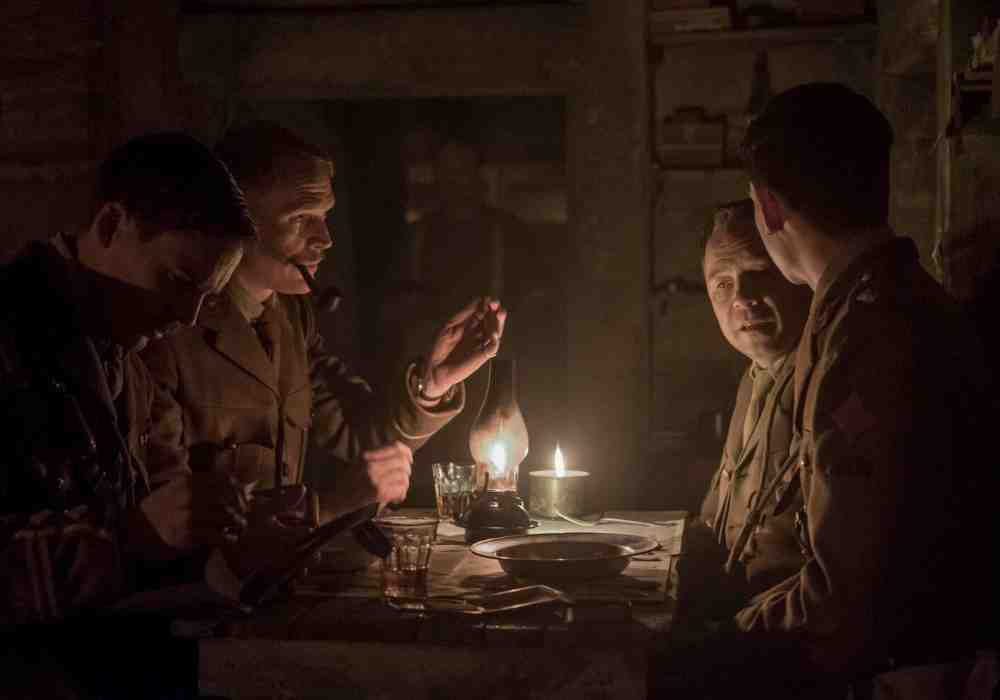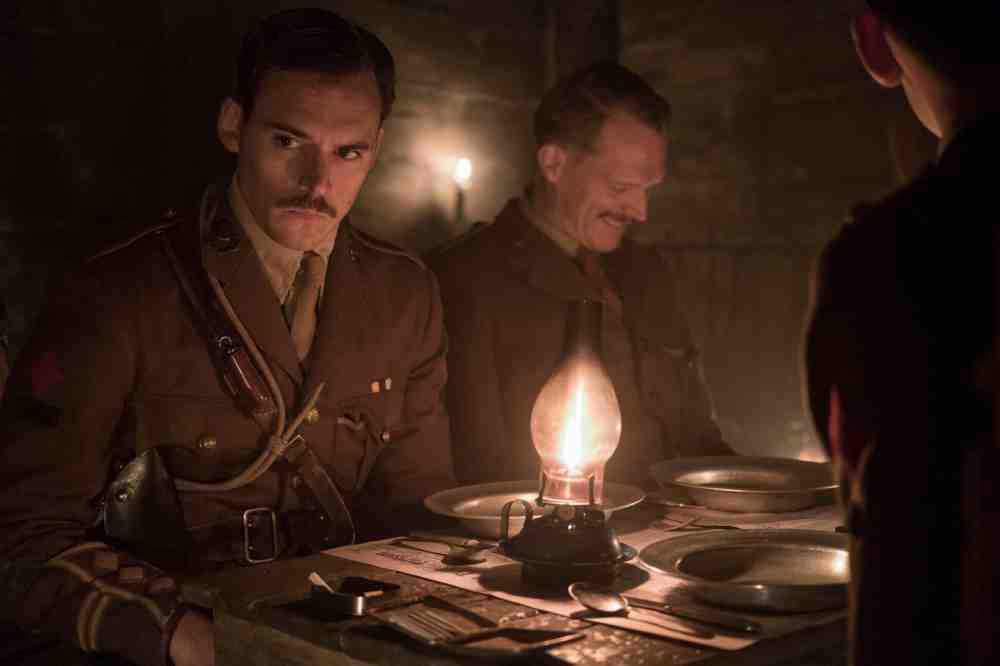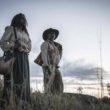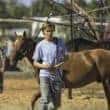Saul Dibb’s adaptation of the acclaimed play Journey’s End sees the source material through a modern lens and makes use of the intimacy unique to the cinematic form.

World War I trench warfare has proved a great crucible for storytelling on stage — or for stories that might as well have been written for the stage. Soldiers confined to a small space, in a lengthy war of casualties, find themselves in a kind of purgatory waiting to die, staying sane by keeping up appearances. R.C. Sheriff’s 1928 play, Journey’s End, was one of the first to dramatize this part of the Great War, but many more have followed — among them The Wipers Times and, one might argue, the mostly single-set final series of Blackadder.
Sheriff’s play finds a group of British officers in a trench in 1918, just as a fatal German attack is expected. With a title like Journey’s End, the question is not whether any (or all) of the characters will die, but what do you do when you know you’re going to die? How do you carry on living and, literally, fighting? The show must go on, and the soldiers must keep up appearances with that Stiff Upper Lip. It’s an idea so inherently theatrical, the characters performing for each other as well as for the audience, that it seems a potentially poor fit for film.
[clickToTweet tweet=”‘With a title like JOURNEY’S END, the question is not whether any (or all) of the characters will die, but what do you do when you know you’re going to die?'” quote=”‘With a title like JOURNEY’S END, the question is not whether any (or all) of the characters will die, but what do you do when you know you’re going to die?'”]
Fortunately, Dibb’s set design and shot selection preserve a sense of meta-theatrical performance, showing us when these men are ‘turning it on’ for each other. Instead of limiting himself to one set, Dibb creates pseudo-stages within the world of the trenches. The officers’ quarters, where the majority of the action (or inaction) occurs, are at the bottom of a flight of stairs leading out from the trenches. It’s a private space — an almost backstage area for the officers to drop the façade of confident leadership. Within their quarters, a curtain separates the kitchen from the common space,. Behind the curtain, Mason (Toby Jones) and his staff do their cooking and eavesdrop on the officers’ news. By giving us occasional access to this kitchen, and the reactions of its workers to what the officers discuss, Dibb reminds us that even in this private space, the offers are scrutinized, however quietly, by their staff.
Shooting on location allows for a more immersive experience, which is key to what makes the film modern. Dibb’s film deals directly with the claustrophobia and PTSD of trench warfare by giving us a taste of it ourselves. Moving beyond limited sets allows Dibb to comment on the bureaucratic machinery of war by giving us a big picture perspective that would be impossible on stage. Most importantly, the screen allows for small, subtle performances, which is key to psychological truth: these men are acting for each other, but in subtle ways, and they’re constantly breaking ‘character’, unleashing their fears, whenever they think no one is looking.
[clickToTweet tweet=”‘These men are acting for each other, but in subtle ways, and they’re constantly breaking ‘character’, unleashing their fears, whenever they think no one is looking.'” quote=”‘These men are acting for each other, but in subtle ways, and they’re constantly breaking ‘character’, unleashing their fears, whenever they think no one is looking.'”]
Fresh-faced Raleigh (Asa Butterfield), straight out of prestigious public school and army training, serves as an audience surrogate and ingenue. British public schools are the province of the very wealthy, and sheltered Raleigh has no experience of privation or danger. The officers’ performances become almost entirely for Raleigh’s benefit, to help him maintain his innocence for as long as possible. When Captain Stanhope (Sam Claflin) enters the Officers’ quarters for the first time since Raleigh’s arrival, cursing the poor equipment they’ve been left with to withstand a German attack, his fellow officer Osborne (Paul Bettany) quietly warns him to stop. Stanhope’s demeanour immediately shifts. He shoos away the whiskey he had just ordered (and has clearly been relying on to survive) and is back on his best behaviour. Quick cuts to reaction shots of the men reveal that they’ve noticed how Raleigh’s presence changes Stanhope, and thus their own rules of behaviour. Raleigh and Stanhope went to school together, and neither is quite prepared for Raleigh to see Stanhope just barely coping with PTSD.
Become a member now and you’ll gain access to free eBooks, our entire back catalogue of content, and more exclusive content.
This space, the Officer’s quarters, we intuit, had been his one refuge, where he could drop all facades and open his mind to Osborne. Raleigh’s presence puts a stop to that. When Raleigh leaves to do his first inspection of the troops with Trotter (Stephen Graham), Dibb lingers on Stanhope who waits and watches Raleigh disappear up the stairs and into the trench proper. Only then does Stanhope turn back to Osborne and lay bare how he’s feeling. As the oldest and most clear-headed amongst the officers, a school principal by profession, Osborne is the designated father figure (they call him ‘uncle’). He keeps up morale, Stanhope’s most of all. Stanhope is angry that Raleigh’s presence bars him from drinking openly and unfolding his mind when away from the men. But the need to keep it together for the boy gives him a renewed sense of purpose.
The gift of film is that an actor can register the smallest expression, which the camera picks up but the characters around him would miss. It’s especially true in the film’s best scene: minutes before Raleigh and Osborne are set to lead an ill-advised and seemingly futile raid on the Germans, they share a glass of whiskey and a chat. Osborne has spent the preceding scenes preparing for his death, but in this moment, he acts as if he’ll be back alive, for Raleigh’s sake, chatting on about gardening and coffee. But every time Raleigh isn’t quite looking, Osborne’s mask cracks, and we see the abject terror, sadness, and regret come over him. As they await the charge into battle, Raleigh keeps trying to change to subject to the Germans and the fight, but Osborne simply enjoys his one last pipe, makes light of the precautions he’s taking for his death, and does everything he can to buck up Raleigh. If he goes, it won’t be with a whimper, but a bang.

When a new theatrical revival gets mounted, the company and the critics usually ask, “Why this play now?” The question seems especially relevant for Dibb’s film adaptation of Journey’s End. Despite its age, the play continues to be in regular rotation, most recently in London in 2011 and in Belgium, in a site-specific in-the-trenches production, in 2017-18. And there’s already a black-and-white film from 1930. So why make yet another film of the play now?
Much has changed in our perceptions of WWI in the last seventy years. The story we tell now is less one of British triumph in a Great War, and more about millions of lives unnecessarily lost and a generation of men psychologically scarred by their experiences. Dibb’s film thus seems like a modern day corrective, updating the story for the screen to portray what we now know about the long-term effects of war. And like all films, it offers the opportunity to gather a strong cast of stars that it might not be possible to gather on stage for the length of a regular run.
[clickToTweet tweet=”‘The story we tell now is less one of British triumph in a Great War, and more about millions of lives unnecessarily lost and a generation of men psychologically scarred by their experiences. Dibb’s film seems like a modern day corrective.'” quote=”‘The story we tell now is less one of British triumph in a Great War, and more about millions of lives unnecessarily lost and a generation of men psychologically scarred by their experiences. Dibb’s film seems like a modern day corrective.'”]
Sam Claflin is an uneven actor, but he’s at his best when his role is by nature performative. His posh prick in The Riot Club, a boy constantly performing his privilege and intelligence, was one of the best performances in a film full of Britain’s Bright Young Things. As Finnick in The Hunger Games, he struck the perfect balance as the smiling hero for the cameras and the trauma-stricken softie beneath. His work in My Cousin Rachel as a dupable ingenue and in Me Without You as a charmingly pompous paraplegic was passable at best. But fortunately for Claflin, Stanhope is a performer: a scholarship kid who had to fit in at his elite public school and a PTSD-ridden soldier in a constant state of terror who has to keep up appearances for his men and later Raleigh. It’s some of Claflin’s best work.
The rest of the ensemble is strong, with the exception of Tom Sturridge’s one-note whimpering mess. Paul Bettany is the clear standout performer of the film. He has always been a top notch character actor, but Journey’s End is the first time he’s really had anything to sink his teeth into since 2003’s Master and Commander. It’s a small but important role with dramatic heft: he has to balance his character’s attempts at keeping the atmosphere light with the inner turmoil he’s working hard to mask. Stephen Graham plays a lower-ranking officer who knows there’s no place to show his fallibility. Toby Jones, as Mason the cook, puts on a perky performance before disappearing into the kitchen, where he can let the full weight of his terror and pessimism hang out. As the ingenue, Butterfield gradually progresses from a kid with no idea what he’s in for to one increasingly aware of the dangers, his own mortality, and how broken those around him are.

These performances dovetail nicely with Dibb’s intention to keep us in the soldiers’ headspace. By shooting on location, we have a visceral feel for the claustrophobia of the characters’ quarters, their heads just inches away from the ceiling in a space dimly lit by candles. Though the camera could take us out of the trenches to survey the scenery, Dibb doesn’t let us see anything the soldiers can’t, so we feel the frustration of keeping our heads stuck underground even as the harsh sunlight pours in — it hardly feels like the great outdoors so much as a cold dungeon where you can see every breath. The brief detours into Stanhope’s mind — his hallucinations and his nightmares — are less successful, since these intensely subjective moments feels like a break from the ensemble nature of the piece. But this choice does help bring in a modern understanding of the psychological damage of warfare.
The most modern addition are the bookends to the film, which give us a sense of the scope of the machinery of the British Army — how many people are involved, how many lives stand to be lost, and just how alone these soldiers are out in the trenches. It’s how we see The Great War now, as an unnecessary, poorly managed exercise in military futility. The film’s opening shows us the men assembling in their unit after enjoying a drink at the bar on leave. A troop of uniformed men march toward the trenches, illustrating the weight of Stanhope’s responsibility. The soldiers they’re relieving pass by in the opposite direction, only they’re carrying supplies away from the trenches, in anticipation of an attack the British don’t expect to win. Stanhope’s men are purposefully being left under-equipped so that the supplies won’t be lost in the battle.
Bright-eyed and bushy-tailed Raleigh encounters a different version of the British Army: at base camp, the uniforms are clean not disheveled; the men are welcoming; and the sheer scale of the operation gives you confidence in its ability to succeed. When he asks for a risky assignment, he doesn’t really believe it will be his last. It’s the image the British Army wants to project, and it takes some time, even in the trench, for Raleigh to see what Stanhope sees too clearly and what we’re met with from the start.
What’s surprising is that Dibb’s interpretation isn’t more class-conscious. WWI was still a time when privilege, birth and education determined army rank. The play never detours away from the officers to give us a taste of the horrors the ordinary soldiers face, nor does it even acknowledge that the officers’ experience is far from the norm. That’s to be expected in a piece written by an officer at a time when the merits of this system weren’t questioned. But in an adaptation with such a deliberately modern bent, it’s a curious omission to not even acknowledge that these characters’ face far better conditions than the men they command, even as the film immerses us in their misery and camaraderie.
Many single location films are shallowly criticised for being too ‘stagey’ when they are anything but: The Party creatively expands on its tiny set; theatre director Dominic Cooke gave a one-room conversation gravitas in On Chesil Beach. Stage to screen adaptations The Deep Blue Sea, Una, and Girl Asleep all intelligently utilise the cinematic form, whereas some films are less successful, such as last year’s Marjorie Prime.

